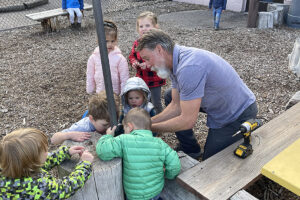The Power of Awe in Learning and Faith
What do neurons, the vastness of the universe, the Fibonacci sequence, Beethoven’s Ninth Symphony, the rainforest, campfires, Shakespeare, the Civil Rights Movement, breakdancing, football, ethics, welding, and Creation all have in common? Would you be surprised to learn that the common thread is awe? At Front Range Christian School (FRCS), we seek to cultivate a deeper level of learning through a faith-infused, Bible-centered, liberal arts education. We are always seeking ways to help students engage deeper with their education, and one powerful element that can transform understanding is awe. While awe is often thought of as an emotional experience, it is also a catalyst for deeper learning. When we experience awe, our sense of wonder opens new pathways for understanding, sparking curiosity and enriching our engagement with the stories, materials, and objectives in education.
This past November, I had the privilege of attending a presentation on “awe” with some FRCS faculty members. One statement that particularly struck me was when the speaker claimed that awe is not simply a good experience, but that it is vital for students to have in their lives. Over the past decade, many young people have lost this essential connection in their world. The speaker went on to explain that without awe, it becomes difficult for students to experience the full depth of life’s wonders, whether in nature, relationships, or the academic subjects they study.
As educators and parents, it is important for us to help students rediscover this emotional connection and to create more opportunities for students to experience awe in their learning journey and life. Creating awe can help spark curiosity and invite students to explore beyond the surface of just retaining facts or knowledge or just going through daily routines. Awe can help people to ask more and deeper questions and seek greater connection, meaning, and understanding.
Awe also has a unique connection to faith. In fact, awe is central to Christianity. Tyler Staton of Bridgetown Church shares in one of his sermons (shout out to Ms. Funk for sharing this sermon with me) that when you read the Bible from cover to cover, one common thread runs through it: awe. He states: “The glue that holds this book together is awe.” Awe is woven throughout Scripture and is a collection of stories of awe. From Moses encountering the burning bush to the disciples witnessing the resurrection, the Bible is filled with stories of ordinary people encountering an extraordinary God, leaving them “dizzy with awestruck wonder.” Staton continues: “Awe is the beginning of Christianity.” I believe that awe can help us approach God with reverence, excitement, and wonder. It encourages a deeper relationship with the Creator and calls us to respond with gratitude and worship.
As we approach the Christmas season, I can think of no better example of awe than the Christmas story itself. How can one not be filled with awe when considering the miraculous birth of Jesus Christ? The birth in a manger, the majesty of the angelic announcement to the shepherds, the wonder of a child who is both God and man. This is a story that transcends the ordinary and leads us into the extraordinary. The Christmas story is awe-filled from beginning to end, drawing us into the mystery and wonder of God’s incredible love and plan for humanity.
As we celebrate Christmas, I encourage students and families to take time to reflect on the awe that fills the Christmas season. Yes, the lights, music, presents and all the activities are awe-mazing. However, the awe of God’s incredible gift of Jesus Christ is truly awe-inspiring. This Christmas season, may we all experience the awe that comes with recognizing the greatness of God and the beauty of His creation, both in learning and in our faith.







